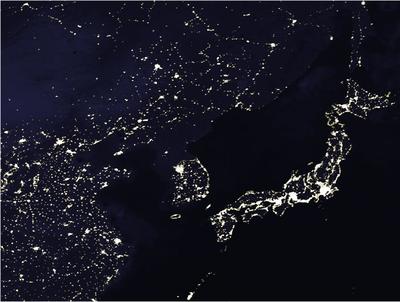In the span of two days, North Korea has test-fired five (short-range) missiles and performed a nuclear detonation test. This is of course a serious matter, especially since the city of Seoul is essentially adjacent to the border and would probably be destroyed in a full-scale conflict. However, I still have trouble taking the threat of a nuclear North Korea seriously. The image below is just one reason why.
 See that vast dark area between mainland China and South Korea? At night, North Korea is dark from space – South Korea, China, Japan all shine brilliantly (as you would expect any industrial society would) but NK is virtually prehistoric. This is not the mark of a civilization that can feed its own people, let alone sustain the extensive engineering and scientific infrastructure needed to develop a working nuclear weapon.
See that vast dark area between mainland China and South Korea? At night, North Korea is dark from space – South Korea, China, Japan all shine brilliantly (as you would expect any industrial society would) but NK is virtually prehistoric. This is not the mark of a civilization that can feed its own people, let alone sustain the extensive engineering and scientific infrastructure needed to develop a working nuclear weapon.
The central dogma of the NK regime is juche, which translates loosely to “self-reliance”. Unfortunately, juche is a lie, since NK is propped up solely by virtue of oil and food shipments from China. However, the NK nuclear program may be the closest thing to genuine juche that the regime has yet achieved, with the entire thing completely home-grown – and it shows:
North Korea claimed Monday that its second nuclear test was more powerful and better controlled than its 2006 test, which many experts characterized as a semi-failure.
But several U.S. experts on nuclear weapons said Monday’s test demonstrated that the North Koreans have not yet mastered the technology of creating a reliable nuclear bomb.
“The simplest hypothesis is that they’re trying to build a weaponizable device and they’re still not that good at it,” said Jeffrey Lewis, director of the Nuclear Strategy and Nonproliferation Initiative at the New America Foundation, a nonprofit group.
The explosive yield from Monday’s test was in the range of 2 to 4 kilotons, which is two to five times that of the 2006 test, according to Siegfried S. Hecker, a periodic visitor to North Korea’s nuclear complex in Yongbyon who is a former director of the Los Alamos National Laboratory and current co-director of Stanford University’s Center for International Security and Cooperation.
“You would expect 10 to 20 times that yield,” said Theodore Postol, a professor of science, technology and national security policy at the Massachusetts Institute of Technology. “These guys have not solved the problem.”
On a technical level, Postol said, the North Koreans appear to be having trouble building a device that uses explosives to compress plutonium into a perfect ball, which creates a uniformly spherical implosion and the maximum possible explosive yield.
“It means they are not yet able to confidently build an experimental weapon and they may not be able to determine what they did wrong,” Postol said.
[…] North Korea has for years been the target of international sanctions intended to limit the country’s access to bomb and missile-making technology. But a senior administration official said that although the sanctions have undermined the North’s economy, they have had little direct effect on its “entirely indigenous” nuclear program.
The government mines its own uranium, builds laboratories using its own technical expertise and generates its own plutonium, making it hard to stop the process from the outside, the official said.
In summary – they arent even close to being a threat, and they know it. As the Washington Post notes, the 2006 test was used as a bargaining chip for more food and aid. I think it is likely that NK is trying to shake the tree again, to try and conceal its weak hand. And there may be other, internal political reasons as well: Kim Jong-il’s health has been frail of late and his son is being groomed for takeover.
During NK’s earlier nuclear test in 2006, Joe Biden called NK a “paper tiger”. I recall how prior to the Iraq War in 2003 we were treated to tales of Saddam’s army might, but when actual conflict ensued, it was a ultimately no contest. North Korea makes Saddam-era Iraq seem like a superpower in comparison. It is hard to see how NK can be a credible threat in the long term, given how fragile and precarious its situation is. As James Fallows wrote in the Atlantic a few years ago, NK is undergoing the Seven Stages of Collapse in slow-motion. Unfortunately, the people of North Korea continue to suffer in the interim.
Related: I’ve written extensively on North Korea before. Fans of the Wrinkle in Time fiction series may particularly appreciate my analogy of NK to Camazotz.

